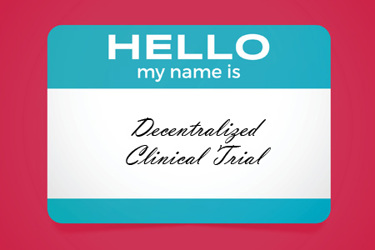Decentralized Clinical Trials: Are We Using The Best Terminology For Patients?
By Sonia Houston Pichardo, Yared Santa-Ana-Téllez, and Amy Rogers, IMI T@H Glossary Working Group on behalf of the Trials@Home Consortium

In a July 2021 Clinical Leader article, Karen Roy proposed that the term “decentralized clinical trials” is a “Terrible Name for a Promising Innovation” and suggested alternatives such as direct-to-patient trials, patient-centric trials, and home-based trials.
As professionals working in clinical trials, we must acknowledge their ever-increasing complexity, driven, in part, by efforts to improve patient centricity through the use of digital health technologies and innovative operational strategies. But does our terminology need to be just as complex as our trials?
In answering this question, we should consider our audience. There is a need within the professional clinical trials community for a generally understood broad term to describe clinical trials that “make use of digital health technology and other related methods to make them more accessible to participants." This working definition of decentralized clinical trials (DCTs) was drafted by the Glossary Working Group (GWG) of the Trials@Home Consortium. The Trials@Home project is a Europe-based academic/industry consortium funded by the Innovative Medicine Initiative to explore the opportunities of moving clinical trials from the traditional clinic setting to the participant’s immediate surroundings. This five-year project uses innovative clinical trial methods and digital technologies to improve trial accessibility by moving trial activities closer to participants.
In the Trials@Home GWG, we continue to prepare and improve upon the glossary of terms and definitions used within the Trials@Home project. Our group has membership across the consortium, representing all project work packages, with two co-leads from the European Federation of Pharmaceutical Industries and Associations (EFPIA) and academic consortium partners who aim to balance industry and public perspectives. The Trials@Home Patient Experience Panel (PEP) has also reviewed the project glossary and continues to contribute their expertise on how best to communicate with potential participants and the general public. The full Trials@Home Glossary can be found here.
As trials incorporate new health technologies, a process accelerated by COVID-19 pandemic restrictions, clinical trial terminology has changed rapidly to reflect this, using terms such as virtual, digital, and remote clinical trials that often have been used interchangeably1. The Trials@Home Executive Board decided to move away from the term remote decentralized clinical trials (RDCT), previously used in the project, and toward decentralized clinical trials (DCTs). This decision recognized prevalent usage across the trials community and in regulatory communications. This change has had many downstream consequences for project documentation, website content, and, of course, mindset shifting for the consortium members.
What Does “DCT” Mean To Trial Participants?
While a single term, such as DCTs, can have clear advantages for communication between professionals, is it as helpful for clinical trial participants? Can we do more to help participants understand what we mean when we talk about decentralized clinical trials?
Despite its increasing use, “decentralized clinical trial” falls short in highlighting the envisioned benefits for clinical trial participants. The term “decentralized” does not suggest that the trial activities are centralized from the participant’s perspective and may even suggest the opposite.
Imagine a potential trial participant receiving an invitation to join a “decentralized clinical trial” or hearing about this trial method from a peer. Outside of the doctor’s office, many participants’ journeys into clinical research will involve web browser searches (e.g., Google or Microsoft Bing). The term decentralized clinical trial's broad nature and non-specific constituent words are likely to produce highly varied expectations. Has the potential trial participant learned any more about what a decentralized trial would mean for them?
We risk losing public interest and potential trust if we have not thought through the language we use with patients and participants. This will be tough to correct if unfamiliar decentralized clinical trials become associated with worries that trial participants are being exposed to additional risks or burdens.
The Trials@Home Glossary was initially envisaged as a tool to improve communication within the project. However, it also has great potential to act as a public resource for explaining these innovative clinical trials. A Trials@Home Sustainability Working Group is considering the best way to maintain the resources created within the project to benefit the clinical trials community. We are also in the initial stages of collaborating with external partners to ensure alignment on informative, inclusive, and acceptable terminology for all stakeholders.
Perhaps we need to be bolder and develop an entirely new word for describing these trials. After all, many common English words are portmanteaus that have arisen from an unmet language need (e.g., meld (melt/weld), internet (international/network), and smog (smoke/fog)).
Whatever terms we end up using, precise terminology is essential for communicating with patients, participants, and each other. Until we come up with a better name, decentralized clinical trials will remain a terrible but useful name for one of the most exciting developments in clinical trials today.
If you think you have an improvement over the terms virtual or decentralized clinical trial, we invite you share it with our glossary working group.
The Trials@Home project has received funding from the Innovative Medicines Initiative 2 Joint Undertaking under grant agreement No 831458. This Joint Undertaking receives support from the European Union’s Horizon 2020 research and innovation programme and EFPIA. To learn more, please visit www.imi.europa.eu. This article only reflects the personal view of the stated authors and neither IMI nor the European Union, EFPIA, or any Associated Partners are responsible for any use that may be made of the information contained herein.
Reference
- Santa-Ana-Tellez, et al. (2022). What are remote, decentralised, patient-centric, site-less, virtual, and digital clinical trials? From confusion to consensus [Manuscript submitted for publication]
About The Authors:
 Sonia Houston Pichardo is product owner of Boehringer Ingelheim’s MyStudyWindow patient engagement web platform. A graduate of Spelman College and University of Missouri-Columbia, where she obtained a Ph.D in physiology and medical pharmacology, she has spent the last 20 years working in New York-based hospitals and academic institutions as well as global CROs. Her clinical research experience spans projects for both drugs and devices. She joined the IMI Trials@Home Consortium at its inception and currently serves as its co-lead alongside Amy Rogers for the Glossary Working Group (GWG).
Sonia Houston Pichardo is product owner of Boehringer Ingelheim’s MyStudyWindow patient engagement web platform. A graduate of Spelman College and University of Missouri-Columbia, where she obtained a Ph.D in physiology and medical pharmacology, she has spent the last 20 years working in New York-based hospitals and academic institutions as well as global CROs. Her clinical research experience spans projects for both drugs and devices. She joined the IMI Trials@Home Consortium at its inception and currently serves as its co-lead alongside Amy Rogers for the Glossary Working Group (GWG).
 Yared Santa-Ana-Tellez is a postdoctoral researcher at Utrecht University in the Netherlands. She is also a health economist from the National Institute of Public Health in Mexico. She obtained her Ph.D. from Utrecht University. Some of her research interests include clinical trial regulations, data management in clinical trials, cross-national comparisons of medication use, and the evaluation of interventions that promote appropriate medication use.
Yared Santa-Ana-Tellez is a postdoctoral researcher at Utrecht University in the Netherlands. She is also a health economist from the National Institute of Public Health in Mexico. She obtained her Ph.D. from Utrecht University. Some of her research interests include clinical trial regulations, data management in clinical trials, cross-national comparisons of medication use, and the evaluation of interventions that promote appropriate medication use.
 Amy Rogers is a clinical lecturer at MEMO Research, University of Dundee, where she has worked on several large pragmatic clinical trials, including TIME, FAST, and ALL-HEART. After graduating MBChB (with commendation) from the University of Aberdeen, Rogers worked for several years as a General Medical Practitioner (GP) in NHS Scotland before commencing her career in clinical research. Her research focuses on developing novel clinical trial methods, building on her MD research that examined pragmatic clinical research methods for learning healthcare systems, and patient and public involvement to support research implementation. She works on the IMI-funded Trials@Home project developing guidance, tools, and recommendations to support decentralized clinical trials in Europe.
Amy Rogers is a clinical lecturer at MEMO Research, University of Dundee, where she has worked on several large pragmatic clinical trials, including TIME, FAST, and ALL-HEART. After graduating MBChB (with commendation) from the University of Aberdeen, Rogers worked for several years as a General Medical Practitioner (GP) in NHS Scotland before commencing her career in clinical research. Her research focuses on developing novel clinical trial methods, building on her MD research that examined pragmatic clinical research methods for learning healthcare systems, and patient and public involvement to support research implementation. She works on the IMI-funded Trials@Home project developing guidance, tools, and recommendations to support decentralized clinical trials in Europe.
